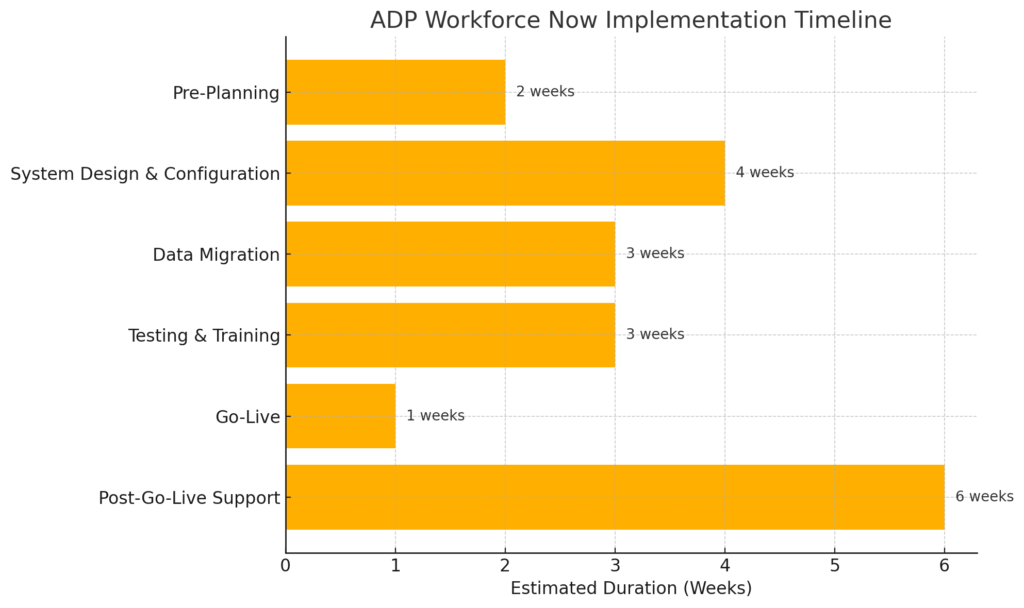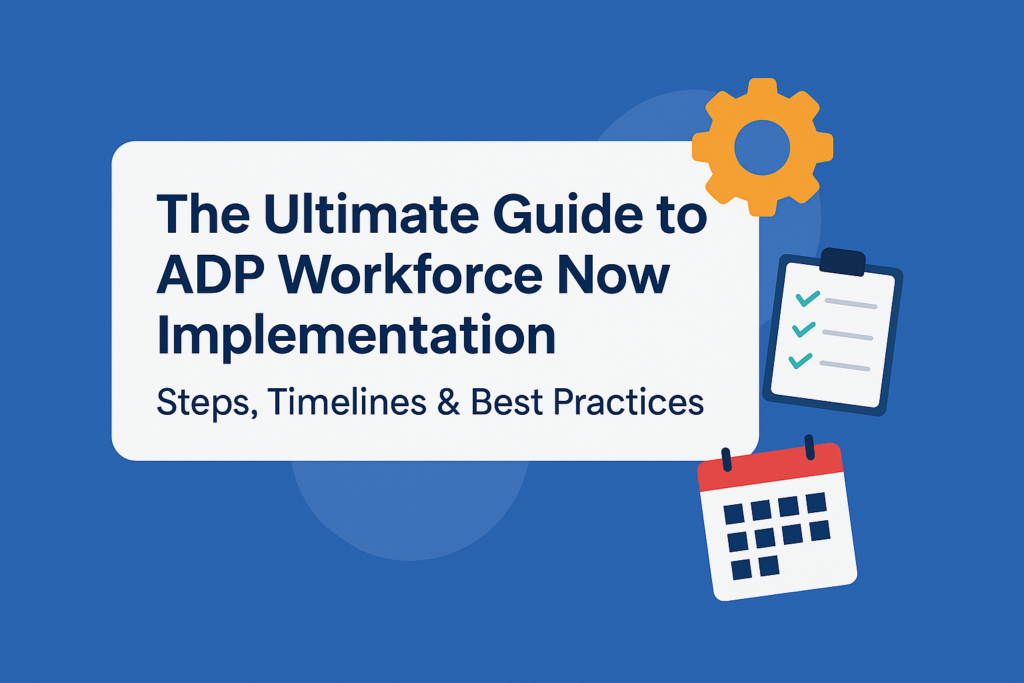Implementing a new Human Capital Management (HCM) platform like ADP Workforce Now can be a game-changer for your HR and payroll operations—but only if done right. Whether you’re transitioning from a legacy system, scaling a fast-growing business, or consolidating HR functions, the implementation process is critical to success.
This ultimate guide walks you through each stage of the ADP Workforce Now implementation, from planning to post-launch optimization, including realistic timelines, common pitfalls, and proven best practices.
What is ADP Workforce Now?
ADP Workforce Now is a cloud-based HCM suite designed for midsize to large organizations. It offers an integrated platform for HR, payroll, time tracking, benefits administration, talent management, and compliance. Its modular architecture allows companies to scale and customize the system based on specific needs.
Why Implementation Matters
You could have the most powerful software in the world, but if it’s not set up correctly—configured for your processes, data, and goals—it will create more headaches than efficiencies.
Key reasons why implementation success is crucial:
- Ensures compliance with payroll and HR regulations
- Reduces manual work and duplication
- Delivers better employee experience
- Enables accurate, real-time reporting
- Maximizes ROI on your software investment
Phase 1: Pre-Implementation Planning (Week 1–2)
Key Objectives:
- Define goals and success metrics
- Select your implementation partner or ADP consultant
- Assign internal stakeholders
Tasks:
- Conduct internal discovery sessions
- Create a project charter and scope
- Define data migration needs
- Audit existing HR/payroll processes
- Decide which ADP modules will be used
Best Practices:
- Involve both HR and IT from the start
- Document all manual workflows and inefficiencies
- Be realistic about your internal team’s availability
Phase 2: System Design & Configuration (Week 3–6)
Key Objectives:
- Configure ADP Workforce Now according to your business requirements
- Align workflows, rules, and hierarchies
Tasks:
- Set up company structure (locations, departments, cost centers)
- Define payroll and time policies
- Customize approval workflows and permissions
- Integrate with third-party systems (e.g., accounting, ERP)
Best Practices:
- Start simple—focus on core processes first
- Involve end users early in configuration decisions
- Don’t transfer old inefficiencies into the new system
Phase 3: Data Migration (Week 6–8)
Key Objectives:
- Accurately import historical and current employee data
Tasks:
- Clean and validate legacy data
- Migrate employee records, compensation details, job history, etc.
- Test data integrity post-migration
Best Practices:
- Invest time in cleaning data before import
- Only migrate essential historical data (last 3–5 years)
- Backup everything before migration
Phase 4: System Testing & Validation (Week 8–10)
Key Objectives:
- Ensure the system works exactly as intended
- Catch issues before going live
Tasks:
- Conduct end-to-end testing of workflows
- Run mock payroll cycles
- Validate compliance rules and tax calculations
- Perform user acceptance testing (UAT)
Best Practices:
- Test edge cases and rare scenarios
- Let real users test their actual use cases
- Keep detailed logs of issues and resolutions
Phase 5: Training & Change Management (Week 9–11)
Key Objectives:
- Equip users with the skills and knowledge to use the system
- Encourage adoption and reduce resistance
Tasks:
- Train HR, payroll, managers, and employees
- Distribute user guides, videos, and FAQs
- Create internal support channels (e.g., email, Slack, Teams)
Best Practices:
- Use role-based training
- Reinforce learning with real-world scenarios
- Get leadership involved in promoting the system
Phase 6: Go-Live & Parallel Run (Week 11–12)
Key Objectives:
- Launch the system while minimizing disruption
- Run parallel cycles to catch final errors
Tasks:
- Go live with production data
- Run payroll in both old and new systems for comparison
- Monitor system performance and user feedback
Best Practices:
- Have contingency plans
- Over-communicate changes to employees
- Expect and address minor issues
Phase 7: Post-Go-Live Support & Optimization (Month 2–3)
Key Objectives:
- Stabilize operations
- Fine-tune the system based on real usage
- Measure outcomes and optimize continuously
Tasks:
- Adjust workflows as needed
- Schedule regular check-ins with your implementation partner
- Review KPIs such as payroll accuracy and employee satisfaction
Realistic Timeline Overview
| Phase | Duration | Notes |
|---|---|---|
| Pre-Planning | 1–2 weeks | Key for alignment |
| System Design | 3–4 weeks | Varies by modules |
| Data Migration | 2–3 weeks | Depends on data quality |
| Testing & Training | 2–3 weeks | Can run in parallel |
| Go-Live | 1 week | Monitor intensively |
| Post-Go-Live | 4–6 weeks | Focus on optimization |

Common Pitfalls to Avoid
- Underestimating data issues
- Lack of executive sponsorship
- Skipping comprehensive testing
- Overcomplicating early configurations
- Neglecting change management
Who Should Lead the Implementation?
- Project Manager: Owns deadlines and coordination
- HR Lead: Ensures process and compliance alignment
- Payroll Lead: Oversees accuracy in calculations
- IT Support: Handles integrations and technical issues
- ADP Implementation Partner: Brings domain expertise and speed
Final Thoughts: Set It Up Right, Reap the Rewards
A successful ADP Workforce Now implementation sets the stage for greater efficiency, compliance, and a better employee experience. It’s not just about launching a system—it’s about launching it right.
Need help implementing ADP Workforce Now?
We specialize in ADP Workforce Now consulting, implementation, training, and support. Contact us today to schedule a free consultation and get started the right way.





